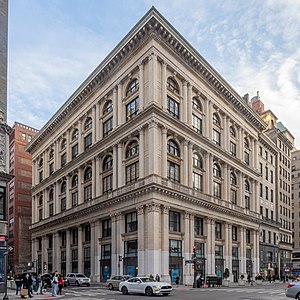Tiffany and Company Building | |
New York City Landmark No. 1624
| |
 | |
 | |
| Location | 401 Fifth Avenue, Manhattan, New York |
|---|---|
| Coordinates | 40°45′00″N 73°58′59″W / 40.75000°N 73.98306°W |
| Area | less than one acre |
| Built | 1905 |
| Architect | Stanford White of McKim, Mead, and White |
| Architectural style | Renaissance Revival |
| NRHP reference No. | 78001886[1] |
| NYCL No. | 1624 |
| Significant dates | |
| Added to NRHP | June 2, 1978[1] |
| Designated NHL | June 2, 1978[2][3] |
| Designated NYCL | February 16, 1988 |
The Tiffany and Company Building, also known as the Tiffany Building and 401 Fifth Avenue, is an eight-story commercial building at Fifth Avenue and 37th Street in the Midtown Manhattan neighborhood of New York City. The structure was designed in the Renaissance Revival style by Stanford White of McKim, Mead & White. It was built from 1903 to 1905 as the flagship store of jewelry company Tiffany & Co. The building is a New York City designated landmark and a National Historic Landmark.
The Tiffany Building has a marble facade inspired by that of the Palazzo Grimani di San Luca in Venice. The facade is divided by large entablatures and cornices into three horizontal tiers; the lowest tier has square piers and rectangular openings, while the second and third tiers have round columns and arched openings. The Tiffany Building has a steel superstructure and a sloped metal roof that resembles a tiled roof. The interior originally comprised seven above-ground stories and two basement levels; a mezzanine was added above the first story in 1952. The basement contained a vault, the first six stories contained various departments of the store, and the seventh story was an exhibition space. The interiors were decorated with various woods, marbles, and Guastavino tiles, much of which has since been removed.
Tiffany & Co.'s president Charles T. Cook developed the building, which cost $600,000 and opened on September 5, 1905. The Tiffany store prospered through the 1920s, but it suffered through the Great Depression. After the company moved to a new flagship store on 57th Street in 1940, the building was occupied by American Red Cross and Textron in the 1940s. Henry Goelet of the Goelet family acquired the building in 1951 and renovated the lower stories, while the upper stories were occupied by Allied Stores from 1950 to 1973. Sun Myung Moon of the Unification Church bought the Tiffany Building in 1977 and used it as a newspaper office. Following a failed plan in the late 1980s to build a tower above the Tiffany Building, the upper stories were used as television studios. The Stahl Real Estate Company bought the building in 2000 and renovated the lower stories.
- ^ a b Cite error: The named reference
nriswas invoked but never defined (see the help page). - ^ "Tiffany and Company Building". National Historic Landmark summary listing. National Park Service. September 19, 2007. Archived from the original on June 6, 2011. Retrieved September 22, 2007.
- ^ George R. Adams (December 1976). "National Register of Historic Places Inventory-Nomination: Tiffany and Company Building" (pdf). National Park Service. Archived from the original on May 16, 2023. and Accompanying 4 photos, exterior, from 1976 and 1905 (1.44 MB)